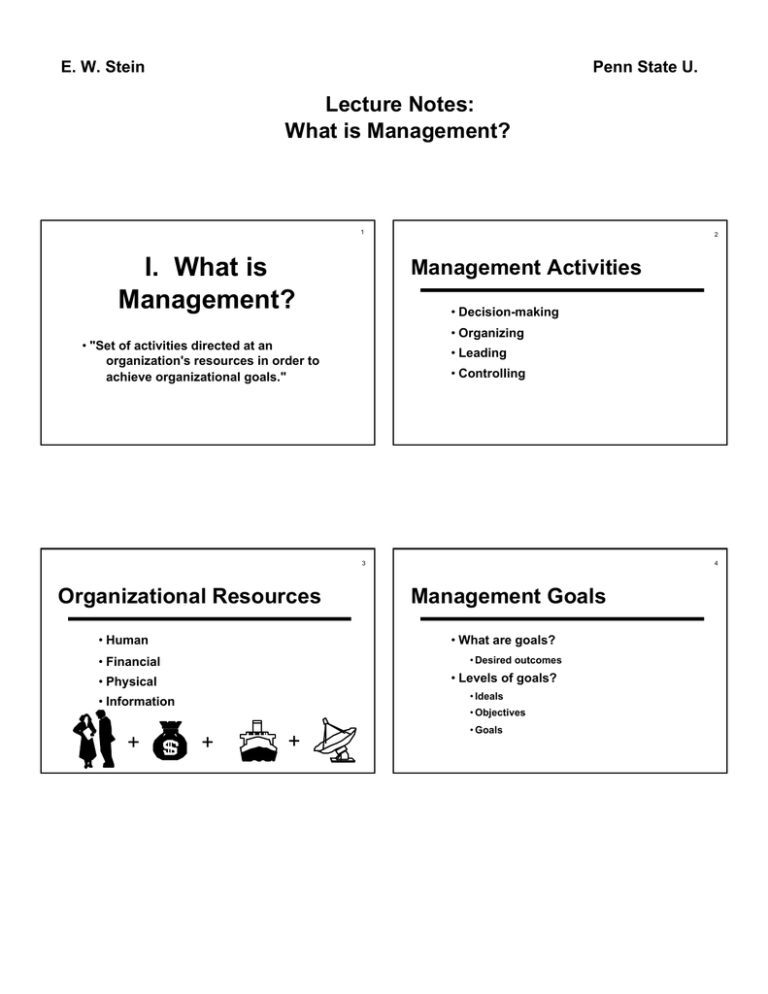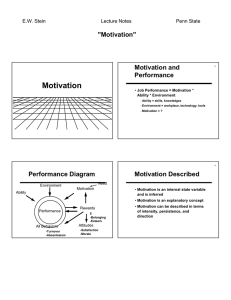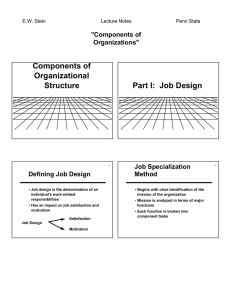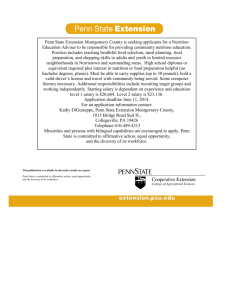I. What is Management? Lecture Notes: What is Management?
advertisement

E. W. Stein Penn State U. Lecture Notes: What is Management? 1 I. What is Management? 2 Management Activities • Decision-making • Organizing • "Set of activities directed at an organization's resources in order to achieve organizational goals." • Leading • Controlling 3 Organizational Resources • Human 4 Management Goals • What are goals? • Desired outcomes • Financial • Levels of goals? • Physical • Ideals • Information • Objectives + + + • Goals E. W. Stein Penn State U. Lecture Notes: What is Management? 5 Measuring Goal Attainment 6 Managerial Roles (Mintzberg) • Effectiveness vs. Efficiency • Interpersonal roles • Effectiveness -doing the right thing • Information roles • Efficiency -doing the thing right (e.g., ratio of inputs to outputs) • Decisional roles 7 Interpersonal Roles 8 Informational Roles • Figurehead -attend functions • Monitor -environmental scanning • Leader -motivate employees • Disseminator -"informate" the organization • Liaison -coordinate activities • Spokesperson -explain initiatives E. W. Stein Penn State U. Lecture Notes: What is Management? 9 Summary of Management Defined Decisional Roles • Entrepreneur -new ideas Management is a process • Disturbance Handler -resolve conflict Managers achieve goals using resources • Resource allocator -review budgets Managers play many roles and engage in organizing, making decisions, leading, and controlling • Negotiator -reach agreement Outcomes measured as efficient and/or effective 11 Part 2: Nature of Organizations and Environments 12 Organizational Environments • Contextual environment • Transactional environment • Value Chain environment • Internal environment E. W. Stein Penn State U. Lecture Notes: What is Management? The Organization's Contextual Environment 13 14 The Organization's Stakeholders • Economic dimension • Transactional stakeholders • Political-legal dimension • Value chain stakeholders • Technological dimension • Internal organization stakeholders • International dimension • Sociocultural dimension 15 16 TRANSACTIONAL ENVIRONMENT Stakeholders Strategic Allies Stakeholder Diagram VALUE CHAIN • A stakeholder is anyone who is affected by and can affect the performance of the organization Owners Suppliers V1 Internal Organization Distributors V3 V2 • Different levels of stakeholders Unions CONTEXTUAL ENVIRONMENT Regulators Customers E. W. Stein Penn State U. Lecture Notes: What is Management? 17 Role of Culture • What is culture? Environmental Change, Complexity & Uncertainty Least Uncertainty • Degree of change Moderate Uncertainty • Degree of homogeneity (complexity) 19 20 Responding to Change • Information management • Strategic response • Mergers and acquisitions Complex Moderate Uncertainty Stable 18 • Dimensions? • How does culture affect the internal environment? Simple Organization-Environment Relationships Most Uncertainty Dynamic • Organizational design • Influencing the environment E. W. Stein Penn State U. Lecture Notes: What is Management? 22 Summary: Organizational Environments Part 3: Management Theory An organization's environment is multidimensional Organizational must manage relationships with different stakeholders Environments create varying degrees of uncertainty Organizations may respond to environmental uncertainty in a variety of ways 23 What is a theory? • Simplification of reality 24 Range of Theories Prescriptive Descriptive Predictive • Identifies variables and the relationships between variables • May describe, prescribe, predict or control Management Theory Physics/Engineering Controlling E. W. Stein Penn State U. Lecture Notes: What is Management? 25 Perspectives on Management 26 Early Management Theorists • Early Ideas • Robert Owen (1771-1858) • Classical Perspective • Importance of human resources; QWL • Scientific Management • Charles Babbage (1792-1871) • Administrative Management • Efficiencies of production; div. of labor • Behavioral Perspective • Quantitative Perspective • Management Science • Operations Management 27 Scientific Management • Frederick Taylor (1856-1915) • Midvale Steel (Phila) Scientific Management (cont1) • Frank and Lillian Gilbreth (1861-1915; 1878-1972) • Determined optimal production time • Redesigned tasks for simplification • Paid workers more who came close to optimal (piecework pay) • Applications of industrial psychology in workplace • What was wrong with this method? • Henry Gantt (1861-1919) • Work scheduling 28 E. W. Stein Penn State U. Lecture Notes: What is Management? Fayol's Principles 29 Administrative Management • Henri Fayol (1841-1925) • Formulated 14 principles that were generalizations or management practice (what kind of theory building is this?) Fayol's Principles (cont) Factor Explanation Centralization Power and authority should be concentrated in upper levels Scalar chain A chain of authority should extend from top to bottom Order Resources should be coordinated Equity Managers should be fair with employees Stability High turnover should be avoided Initiative Subordinates should be encouraged to initiate Esprit de corps team spirit is fundamental to the organization's health Factor Explanation Division of Labor Specialization leads to efficiency Authority Authority is needed to carry out managerial responsibilities Discipline People must respect rules Unity of Command Each subordinate must report to one (and only one) boss Unity of Direction Similar activities should be grouped together Subordination of goals Individual interests subordinate to organizational goals Remuneration Fair compensation to employees 31 Summary of Classical Perspective 1890's to 1930's Focussed on employees and firm productivity Identified key management functions Most appropriate for stable and simple organizations Prescriptions had limited application Many viewed employees as machines or tools 30 E. W. Stein Penn State U. Lecture Notes: What is Management? 33 The Behavioral Perspective Behavioral Perspective (cont1) 34 • Hawthorne Study 1: Illumination and productivity (1927-1932) • Hawthorne Studies • Performed by Elton Mayo; Sponsored by GE • Human Relations Movement • Result: Increasing (or decreasing) lighting in experimental group led to increased production in both experimental and control groups • Why? (A: Both groups received attention) Behavioral Perspective (cont2) • Hawthorne Study 2: Piecework • Performance standards set for task • Individuals showed allegiance to group rather than organizational norms by under-producing 35 Behavioral Perspective (cont3) • Maslow's hierarchy of needs • McGregor's Theory X and Theory Y • Theory X-employees do not like to work; managers must direct and control; people lack ambition • Theory Y-employees like to work and are motivated; need tools to achieve goals; people seek responsibility and are innovative 36 E. W. Stein Penn State U. Lecture Notes: What is Management? Summary of Behavioral Perspective Quantitative Perspective • 1940's to present • Mathematical models of management processes and problems 1930's to 1940's Focus on employee behavior and psychology • Focused on production management Insights into motivation, group dynamics • Very useful for planning and control Considered employees valuable resources • Limitations: not applicable to human behavior; models may be simplistic Limitations: lacks prescriptive capability; not easily implemented in workplace; hard for managers to understand Example of Quantitative Model: Forecasting Sales ($) = .567 Advertising ($) + .341 population (000) + 14559 40 39 Integrative Perspectives • Systems • Contingency • Theory Z E. W. Stein Penn State U. Lecture Notes: What is Management? 41 Systems approach 42 Contingency approach feedback • Argues that there are no universal theories Outputs Inputs • Theories have limited scope and application Organization • Appropriateness is contingent on context Transformation Processes 43 Theory Z (Ouchi) 44 Theory Z (cont.) • Integrates American (Type A) and Japanese (Type J) management practices • Typical J • Seven Dimensions • Typical American • (1) length of employment (2) decision-making (3) location of responsibility (4) speed of promotion (5) control mechanisms (6) career specialization (7) concern for employee • Lifetime employment; collective decision making • Short-term employment; individual decision making E. W. Stein Penn State U. Lecture Notes: What is Management? 45 Theory Z Described • Best of both worlds • One Type A characteristic • Individual responsibility • Three Type J characteristics • Collective decision-making • Long-term employment Summary of Management Perspectives Many perspectives evolved over past century Some favor organizational ends, while others favor needs of individuals Each of the perspectives is represented in today's organizations The key for management is to know how and when to apply the results of each perspective • Holistic concern end... Questions • What is management? • What are goals? • Distinguish between efficiency and effectiveness. • Describe and organization's environment. • What is culture? E. W. Stein Penn State U. Lecture Notes: What is Management? Questions (cont.) • What is a theory • Who was Frederick Taylor? • Who was Henri Fayol? • Explain the Hawthorne effect. • Describe Theory Z








